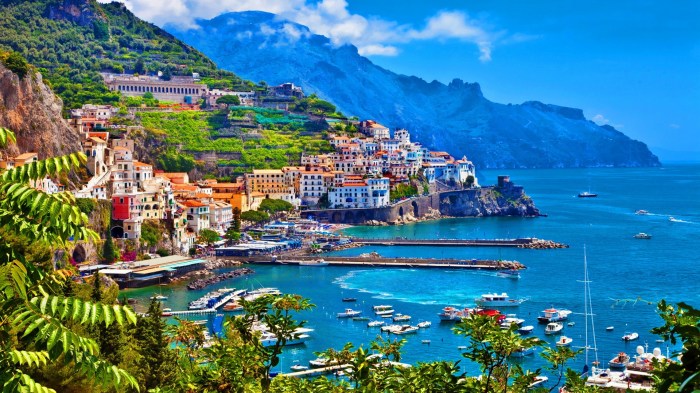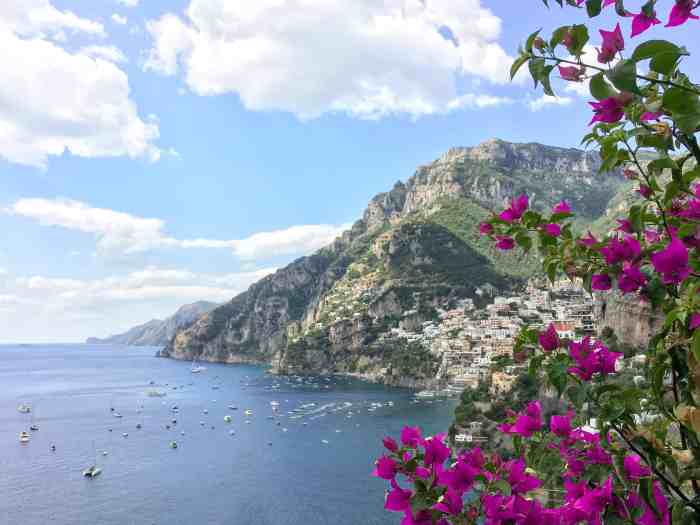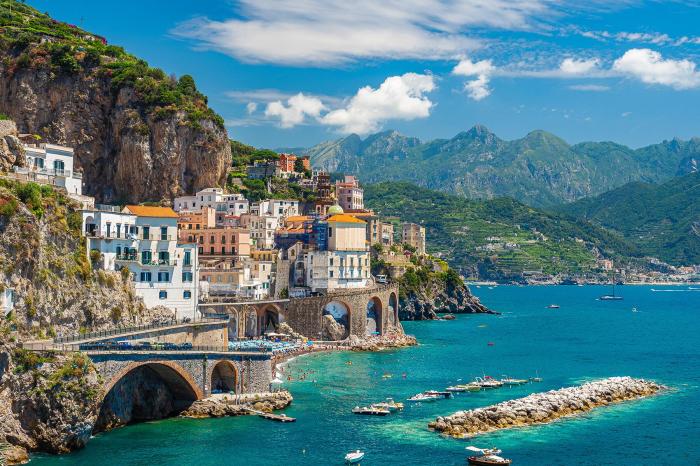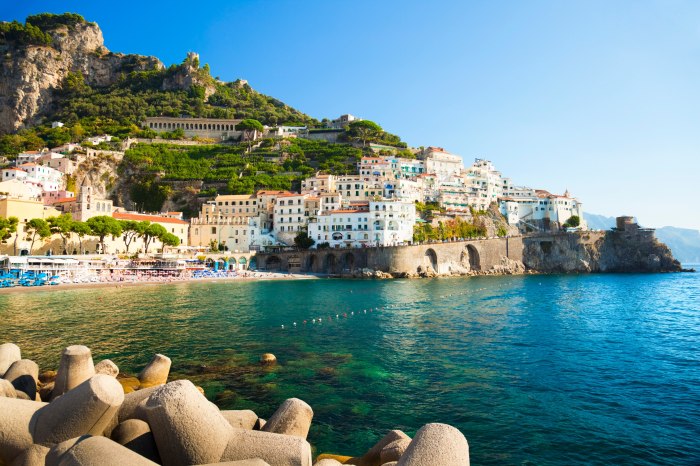Embark on an enchanting journey to the Amalfi Coast Italy, a captivating destination where breathtaking landscapes intertwine with a rich cultural tapestry. From its dramatic cliffs and turquoise waters to its charming towns and historical monuments, this region beckons travelers to immerse themselves in its allure.
Nestled along the southern coast of Italy, the Amalfi Coast boasts a unique topography that has shaped its history and culture. Its rugged coastline, dotted with picturesque villages, has served as a crossroads of maritime trade for centuries, leaving an indelible mark on the region’s heritage.
Geographic and Historical Overview

The Amalfi Coast, a captivating stretch of coastline in southern Italy, is renowned for its breathtaking scenery and rich historical heritage. Nestled along the Tyrrhenian Sea, it encompasses a series of picturesque towns perched atop dramatic cliffs, overlooking crystal-clear waters.
The region’s unique topography is characterized by steep, terraced hillsides and rugged cliffs that plunge into the sea. The coastline is dotted with secluded coves, hidden beaches, and charming villages, each offering a glimpse into the area’s past and present.
The Amalfi Coast of Italy is a breathtaking destination renowned for its stunning scenery and charming villages. Beyond its picturesque allure, the region offers an array of thrilling extreme sports vacations. From rock climbing and paragliding to scuba diving and sea kayaking, there’s an adventure waiting for every adrenaline junkie.
However, amidst the exhilaration of these extreme pursuits, the Amalfi Coast’s timeless beauty remains ever-present, inviting you to unwind and soak in the tranquility of this enchanting land.
Historical Significance
The Amalfi Coast has played a significant role in the maritime trade of the Mediterranean for centuries. During the Middle Ages, the Republic of Amalfi, founded in the 9th century, emerged as a major maritime power. Its strategic location and skilled shipbuilders allowed it to dominate trade routes between Europe and the Middle East.
Amalfi became a wealthy and influential city, known for its production of luxury goods, such as silk and ceramics. It also played a pivotal role in the development of maritime law, with the “Table of Amalfi” becoming one of the earliest known collections of maritime codes.
Natural Beauty and Landscapes

The Amalfi Coast is renowned for its breathtaking coastal scenery, a symphony of natural wonders that captivates the senses. The towering cliffs plunge dramatically into the turquoise waters, creating a stunning contrast between the rugged terrain and the tranquil sea. Dotting the coastline are picturesque villages, their colorful houses cascading down the hillsides, adding a vibrant charm to the landscape.
Flora and Fauna
The Amalfi Coast is home to a diverse array of flora and fauna, a testament to its rich Mediterranean ecosystem. The slopes are adorned with lush vegetation, including olive groves, vineyards, and lemon trees, their fragrant blossoms scenting the air. The waters teem with marine life, from colorful fish darting among the coral reefs to majestic sea turtles gliding through the waves.
Cultural Heritage and Architecture

The Amalfi Coast is a cultural melting pot, having been influenced by various civilizations throughout history. The region’s rich heritage is reflected in its architecture, art, and traditions.
The distinctive architecture of the Amalfi Coast is a blend of Arab, Byzantine, and Norman influences. The colorful houses, churches, and historical monuments are a testament to the region’s vibrant past.
Architectural Styles
- Arabian: Pointed arches, intricate mosaics, and decorative tiles.
- Byzantine: Domed churches with elaborate frescoes and mosaics.
- Norman: Massive stone fortifications, such as the Ravello Cathedral.
Notable Architectural Landmarks
- Amalfi Cathedral: A 9th-century cathedral known for its ornate facade and bell tower.
- Ravello Cathedral: A 11th-century cathedral with a stunning bronze door and a panoramic terrace.
- Villa Cimbrone: A 19th-century villa with lush gardens and a breathtaking view of the coast.
Towns and Villages

Nestled along the rugged coastline, the Amalfi Coast boasts a captivating array of towns and villages, each exuding its own unique character and charm. From the vibrant streets of Amalfi to the tranquil beauty of Positano, these settlements offer a blend of history, culture, and breathtaking scenery.
Amalfi
The historic heart of the Amalfi Coast, Amalfi enchants visitors with its grand cathedral, adorned with intricate mosaics and soaring bell towers. Stroll through its narrow streets lined with charming boutiques and savor the flavors of local cuisine at its lively restaurants.
Positano
Perched on a hillside overlooking the Mediterranean Sea, Positano captivates with its picturesque pastel-colored houses cascading down towards the shore. Explore its cobbled streets, relax on its pristine beaches, and indulge in the romantic atmosphere that permeates the village.
Ravello
Nestled in the hills above Amalfi, Ravello offers a serene escape from the bustling coast. Visit the enchanting Villa Cimbrone, renowned for its breathtaking gardens and panoramic views. Immerse yourself in the town’s rich artistic heritage at its museums and galleries.
If you’re seeking an unforgettable luxury getaway, look no further than the breathtaking Amalfi Coast in Italy. Indulge in luxury travel deals that offer exclusive access to world-class accommodations, gourmet dining, and once-in-a-lifetime experiences. From private boat tours to guided hikes through picturesque landscapes, the Amalfi Coast promises an escape that combines tranquility and adventure.
Local Traditions and Festivals
The towns and villages of the Amalfi Coast are steeped in tradition. Witness the vibrant processions and fireworks displays of the Festa di Sant’Andrea, the patron saint of Amalfi. Join in the lively dancing and music at the traditional Tarantella festivals.
Culinary Experiences
The Amalfi Coast is a culinary paradise, renowned for its fresh seafood, succulent lemons, and fragrant herbs. Indulge in mouthwatering dishes like spaghetti alle vongole, prepared with plump clams, or savor the sweet and tangy flavors of the local limoncello liqueur.
Activities and Experiences

The Amalfi Coast offers an array of activities and experiences that cater to diverse interests. From picturesque hikes and refreshing swims to exhilarating boat excursions and culinary adventures, there’s something for every traveler to enjoy.
The Amalfi Coast in Italy is a breathtaking destination with its stunning cliffs, azure waters, and picturesque towns. As travelers become more conscious of their impact on the environment, it’s important to consider sustainable travel destinations. Sustainable travel aims to minimize environmental impact while supporting local communities.
The Amalfi Coast, with its focus on preserving its natural beauty and cultural heritage, is an ideal example of a sustainable travel destination.
Exploring the coastline by land and sea provides a comprehensive experience of the region’s beauty. Scenic drives along the winding roads offer breathtaking views, while boat excursions allow visitors to admire the coastline from a unique perspective.
Hiking
- Path of the Gods: A legendary trail that traverses the cliffs, offering panoramic views of the coastline.
- Valle delle Ferriere: A scenic hike through a lush valley, featuring waterfalls and ancient mills.
Swimming
- Marina Grande, Positano: A charming beach with crystal-clear waters and stunning views of the town.
- Spiaggia di Santa Croce, Amalfi: A secluded beach nestled between cliffs, accessible by boat or a scenic walk.
Boating
- Boat Excursions: Guided tours or private charters offer opportunities to explore hidden coves, swim in secluded spots, and admire the coastline’s beauty from the sea.
- Ferries and Water Taxis: Regular ferry services and private water taxis connect the towns and villages along the coast, providing a convenient and scenic mode of transportation.
Culinary Tours
- Lemon Groves and Cooking Classes: Visit local lemon groves and participate in hands-on cooking classes to learn about traditional Amalfi cuisine.
- Wine Tasting: Explore the vineyards and sample the region’s renowned wines, including the famous Taurasi and Fiano di Avellino.
Transportation and Accessibility

Reaching and exploring the Amalfi Coast is a breeze with a range of transportation options. Whether you prefer the convenience of air travel, the scenic charm of train journeys, or the flexibility of local transportation, the region is well-connected.
The nearest airport to the Amalfi Coast is Naples International Airport (NAP), located about 60 kilometers (37 miles) north of Salerno. From the airport, you can take a bus, train, or taxi to reach your destination. Salerno Train Station is another major transportation hub, with frequent train services to and from major cities in Italy and beyond.
Once you’re in the Amalfi Coast region, local transportation options include buses, ferries, and taxis. Buses are a budget-friendly way to get around, while ferries offer a scenic and relaxing way to explore the coastline. Taxis are convenient but can be more expensive.
The best time to visit the Amalfi Coast is during the shoulder seasons (April-May and September-October) when the weather is pleasant and the crowds are smaller. However, if you’re looking for the warmest weather and the most vibrant atmosphere, visit during the summer months (June-August).
To plan your trip, consider the following tips:
- Book your flights and accommodations in advance, especially if you’re traveling during peak season.
- Purchase a Campania Artecard if you plan on visiting multiple museums and attractions.
- Allow plenty of time for transportation, as the roads can be winding and traffic can be heavy during peak hours.
- Consider renting a car if you want the flexibility to explore the region at your own pace.
- Be prepared for crowds, especially in popular tourist areas.
Responsible Tourism
The Amalfi Coast is a breathtaking destination that welcomes millions of visitors each year. To preserve its natural beauty and cultural heritage for generations to come, it is essential to promote responsible tourism practices.
Responsible tourism involves minimizing our environmental impact, respecting the local environment, supporting sustainable businesses, and preserving the cultural heritage of the region.
Minimizing Environmental Impact
To minimize our environmental impact, we can:
- Choose sustainable modes of transportation, such as walking, biking, or taking public transportation.
- Reduce our consumption of single-use plastics, such as water bottles and straws.
- Conserve water and energy by taking shorter showers, turning off lights when leaving a room, and unplugging electronics when not in use.
- Dispose of waste properly in designated bins and avoid littering.
Respecting the Local Environment
To respect the local environment, we can:
- Stay on designated trails and avoid trampling on vegetation.
- Respect wildlife by observing from a distance and not feeding or harassing animals.
- Avoid disturbing local communities by being respectful of noise levels and respecting private property.
- Support local businesses that are committed to sustainable practices.
Preserving Cultural Heritage, Amalfi coast italy
To preserve the cultural heritage of the Amalfi Coast, we can:
- Visit historical sites and monuments respectfully, avoiding touching or damaging artifacts.
- Learn about the local culture and traditions and engage with local people in a respectful manner.
- Support local artisans and craftspeople by purchasing souvenirs and products made in the region.
- Respect the privacy of local people and avoid taking photographs without their consent.
Outcome Summary: Amalfi Coast Italy

Whether you seek to bask in the sun-kissed beaches, explore the vibrant streets of its towns, or delve into its culinary delights, the Amalfi Coast Italy offers an unforgettable experience. Its natural beauty and cultural charm will leave a lasting impression, inviting you to return time and again.
FAQ Explained
What is the best time to visit the Amalfi Coast?
Spring (April-May) and fall (September-October) offer pleasant weather and fewer crowds.
How do I get to the Amalfi Coast?
Naples International Airport (NAP) is the closest major airport, with train and bus connections to the coast.
What are some must-visit towns on the Amalfi Coast?
Amalfi, Positano, Ravello, and Sorrento are among the most popular and picturesque towns.